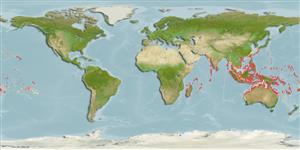>
Ovalentaria/misc (Various families in series Ovalentaria) >
Pomacentridae (Damselfishes) > Chrominae
Etymology: Chromis: Greek, chromis = a fish, perhaps a perch (Ref. 45335).
More on authors: Welander & Schultz.
Environment: milieu / climate zone / depth range / distribution range
Ecologia
marino associati a barriera corallina; non migratori; distribuzione batimetrica 1 - 29 m (Ref. 9710). Tropical; 32°N - 32°S, 43°E - 132°W
Indo-Pacific: most islands of Oceania except Hawaiian Islands, Marquesas, and Pitcairn Group; also Australia north to the Ryukyu Islands. In the Indian Ocean, there are confirmed records Seychelles, Thailand and Western Australia. Often confused with Chromis viridis.
Size / Peso / Age
Maturity: Lm ? range ? - ? cm
Max length : 12.0 cm TL maschio/sesso non determinato; (Ref. 30874)
Spine dorsali (totale): 12; Raggi dorsali molli (totale): 9-10; Spine anali 2; Raggi anali molli: 9 - 10.
Adults inhabit clear lagoons, passages, and seaward reef slopes, in thickets of live or dead coral. They occur in large aggregations feeding above staghorn Acropora corals (Ref. 9710). Stomach contents of individuals examined included mainly copepods, amphipods, and zoea. Diurnal species (Ref. 54980; 113699). Oviparous, distinct pairing during breeding (Ref. 205). Eggs are demersal and adhere to the substrate (Ref. 205). Males guard and aerate the eggs (Ref. 205).
Life cycle and mating behavior
Maturità | Riproduzione | Deposizione | Uova | Fecundity | Larve
Oviparous, distinct pairing during breeding (Ref. 205). Eggs are demersal and adhere to the substrate (Ref. 205). Males guard and aerate the eggs (Ref. 205).
Allen, G.R., 1991. Damselfishes of the world. Mergus Publishers, Melle, Germany. 271 p. (Ref. 7247)
IUCN Red List Status (Ref. 130435)
Warning: mysqli::__construct(): (HY000/1040): Too many connections in /var/www/html/includes/func_getlabel.php on line 46
Can't connect to MySQL database (fbapp). Errorcode: Too many connections
